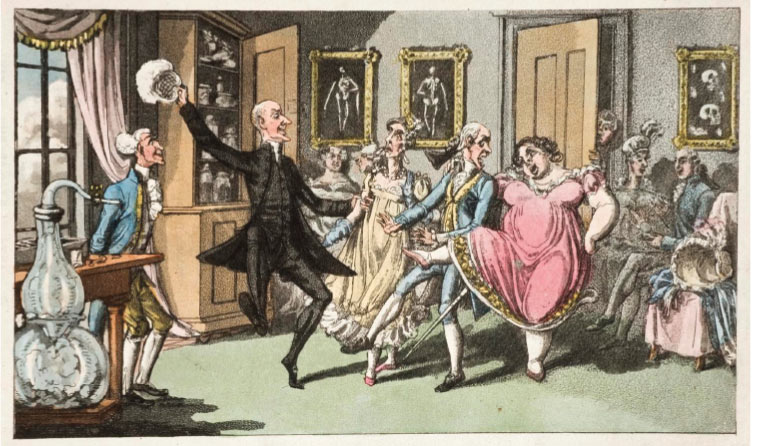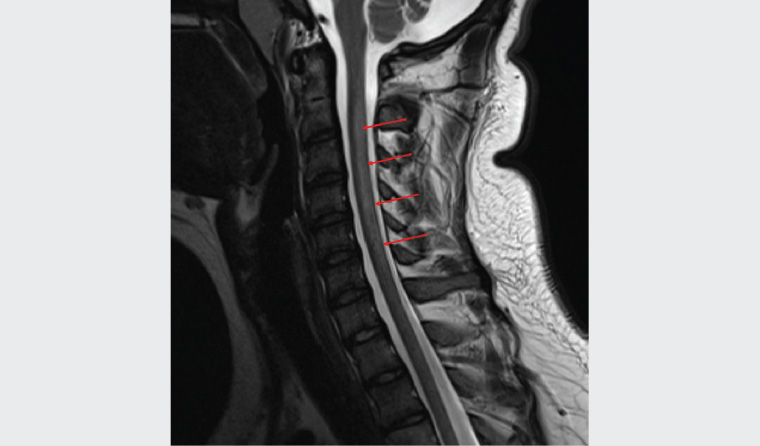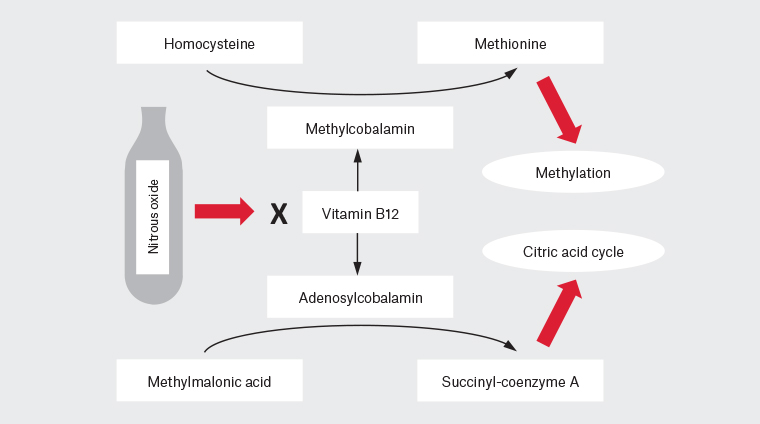Nitrous oxide is a familiar gas in medicine, with both analgesic and anaesthetic properties. It was first isolated in 1772 by the English scientist, philosopher and theologian Joseph Priestley.1 Before any medical application, it became popular at upper class ‘laughing gas parties’ (Figure 1) and public variety performances, where audience members were invited on stage to inhale the gas and entertain the crowd with disinhibited song and dance.2,3
Ease of access and the common misperception of a ‘safe high’ has led to an increase in abuse and consequent neurological morbidity among young Australians.

Figure 1. Doctor Syntax and his wife making an experiment in pneumatics. Depiction of a 19th century ‘laughing gas party’. Reproduced with permission from Science Museum Group, London.13
Case
A female university student aged 18 years presented to her general practitioner (GP) with subacute-onset, progressive distal lower limb sensory symptoms and unsteadiness. She had first noticed symptoms three weeks earlier when she awoke with painful tingling and numbness in both feet. Over the following weeks, the sensory symptoms progressed, and she developed bilateral lower limb weakness and impaired balance such that she was unable to dress herself while standing. She had no bowel or bladder symptoms. At this point she arranged to see her GP, seeking medical aid for the first time. Neurological examination revealed increased lower limb tone. There was marked sensory ataxia with loss of joint position sense to the knees and vibration sense to the anterior superior iliac spine. Sensation to pin was reduced to the mid calves. Power was normal except for moderate bilateral ankle dorsiflexion weakness. Plantar reflexes were bilaterally extensor. Gait was broad-based, and Romberg test was immediately positive. Her GP suspected a neuropathy and arranged blood tests in consultation with a local neurologist. Vitamin B12 level was low–normal with significantly elevated methylmalonic acid (MMA) and homocysteine levels, consistent with functional vitamin B12 deficiency (results summarised in Table 1). Intramuscular hydroxocobalamin was promptly initiated. Having initially, in the presence of her father, denied substance use, she later reported inhaling 25–200 ‘nang’ canisters daily for approximately six months. She was reviewed in the neurology outpatient clinic three weeks later, and she felt that her symptoms were already improving. Magnetic resonance imaging (MRI) of the spine soon after the initial presentation (Figure 2) showed signal abnormality in the dorsal columns from C1 to C7. Lower limb nerve conduction studies showed a length-dependent sensorimotor neuropathy with demyelinating features. Hydroxocobalamin treatment was continued. On repeat clinical assessment six months later there had been further clinical improvement. There was some persisting tingling and sensory loss in the toes. Power was normal. Joint position and vibration sense were present at the knees. Gait was normal, and she swayed on Romberg test but did not fall.

Figure 2. Sagittal cervical spine magnetic resonance imaging at presentation, showing T2-weighted signal abnormality from C1 to C7 levels in the dorsal columns (red arrows), typical of subacute combined degeneration of the spinal cord
| Table 1. Blood test results at presentation and six months’ follow-up |
| |
Presentation |
Follow-up |
Reference range |
| Haemoglobin (g/L) |
148 |
145 |
120–150 |
| MCV (fl) |
92 |
92 |
80–100 |
| Vitamin B12 (pmol/L) |
150 |
1680 |
140–770 |
| Methylmalonic acid (nmol/L) |
1885 |
174 |
0–280 |
| Homocysteine (μmol/L) |
23.3 |
8.3 |
6–12 |
| Folate (μg/L) |
6.3 |
10.4 |
3.1–20.5 |
| Copper (μmol/L) |
14 |
nm |
12–25 |
| HIV serology |
Negative |
nm |
– |
| Fasting glucose (mmol/L) |
4.1 |
nm |
<6.1 |
| HIV, human immunodeficiency virus; MCV, mean corpuscular volume; nm, not measured |
This case highlights the re-emergence of recreational nitrous oxide use. The gas is cheap and easily accessible in the form of small metallic canisters used as a propellant in whipped cream dispensers (Figure 3). Canisters, colloquially called ‘nangs’ or ‘whippits’, can be purchased in bulk from convenience stores or online suppliers that offer quick delivery at any hour, ostensibly for making whipped cream. The gas is discharged into a balloon using a small mechanical ‘cracker’ and then inhaled. The fleeting ‘high’ lasts only for a minute or so, and it is therefore common for people to use tens to hundreds of canisters in a session. Less commonly, patients may seek nitrous oxide by repeatedly presenting to an emergency department with self-inflicted injuries (eg patella dislocation).4

Figure 3. ‘Nangs’ and balloons discarded on a suburban Australian street
While most people who use nitrous oxide perceive ‘nanging’ as relatively safe,3 this is not the case. Emergency department presentations related to nitrous oxide are on the rise,5 and there are increasing case reports of severe neurotoxicity in people who habitually use nitrous oxide. In Australia, nitrous oxide abuse has become a significant public health concern. A large annual study of young people who use drugs showed that recent use (past six months) of nitrous oxide was stable from 2003 (26%) to 2014 (23%), but had more than doubled by 2019 (53%).6 In 2020, the South Australian Government acknowledged the public health risk and passed legislation to ban displaying canisters in shops, selling them to minors and selling them after 10.00 pm.7
Pathophysiology
Nitrous oxide causes oxidation of the cobalt ion in vitamin B12, thereby rendering it inactive. This leads to to functional vitamin B12 deficiency, even with normal stores. Without vitamin B12, homocysteine cannot be converted to methionine, which prevents methylation of myelin proteins4 (Figure 4) and leads to demyelination in the peripheral and central nervous systems. In the spinal cord, there is a predilection for demyelination in the dorsal columns, leading to a myelopathy due to ‘subacute combined degeneration’ of the spinal cord. In the peripheral nervous system, ischaemia has been suggested as another cause of neurotoxicity, unrelated to the direct effect of vitamin B12.4 Other causes of vitamin B12 deficiency may render the patient’s neural tissue more susceptible to the toxic effects of nitrous oxide abuse and should be sought out.

Figure 4. Simplified vitamin B12 pathway. Inactivation of vitamin B12 results in increased levels of homocysteine and methylmalonic acid. Reduced methylation processes result in impaired myelin sheath maintenance.
Clinical manifestations and differential diagnosis
Although the presentation in most reported cases of nitrous oxide neurotoxicity is that of subacute combined degeneration of the spinal cord, this is certainly not the rule, and patients can present with varying degrees of upper and lower motor neurone involvement resulting from the combination of a myelopathy and peripheral neuropathy, respectively. Spinal cord involvement manifests as spasticity, pyramidal pattern weakness and dorsal column sensory loss. Peripheral nerve involvement results in length-dependent large and small fibre sensory loss (often painful)and symmetrical distal weakness. Some patients develop visual disturbance because of optic neuropathy. The result is a combination of spasticity, sensory ataxia and weakness.8 Patients may present with a combination of lower limb spasticity, extensor plantar responses, yet loss of ankle reflexes.
Consequently, the differential diagnosis depends on whether central or peripheral nervous system involvement is clinically most prominent. In essence, one is looking to exclude other causes of a subacute-onset myeloneuropathy, which include metabolic, infective and autoimmune/inflammatory causes. If the presentation is mostly myelopathic, compressive and other toxic causes should also be considered. One should keep in mind the possibility of an ischaemic spinal cord syndrome; however, the history is often abrupt, in contrast to the subacute presentation typical of functional vitamin B12 deficiency. If the lower motor neurone is predominantly affected, causes of a subacute-onset peripheral neuropathy enter the differential diagnosis. One should not forget the possibility of a neoplastic process (eg lymphoma infiltration) involving the conus medullaris +/– cauda equina, giving rise to a combination of upper and lower motor neurone signs, mimicking the myeloneuropathy of vitamin B12 deficiency. Most of these diagnoses are uncommon, as is often the case with individual neurological disease. In reality, if there is a history of nitrous oxide abuse, and congruent clinical examination, the diagnosis is relatively straightforward. Table 2 presents a non-exhaustive list of differential diagnoses that should be considered in the appropriate clinical context. Those that are more common are marked with an asterisk.
| Table 2. Important differential diagnoses for nitrous oxide neurotoxicity. The more common diagnoses are marked with an asterisk. |
| Toxic/metabolic |
| Folic acid deficiency* |
Clinical presentation often occurs alongside, and is identical to that seen with, vitamin B12 deficiency. Low folate and elevated homocysteine. |
| Copper deficiency* |
Subacute-onset posterior spinal cord syndrome ± sensory > motor neuropathy. Can also cause optic neuritis. Anaemia and lymphopenia common. Decreased intake/malabsorption most common. Consider causes of zinc excess resulting in secondary hypocupremia. |
| Zinc excess |
Rare. Chronic excess zinc intake exerts its neurological effect via copper deficiency. Cause often not found. Consider use of zinc-containing denture adhesive paste where appropriate. Hypocupremia, hypoceruloplasminaemia and hyperzincaemia. |
| Heroin |
Acute transverse myelitis. |
| Medications/other drugs* |
The list of medications/toxins that can cause a myelopathy or subacute-onset peripheral neuropathy is legion, and must be considered. |
| Inflammatory/autoimmune |
| CNS demyelination (eg MS*) |
Subacute-onset upper motor neurone syndrome, which can affect the dorsal spinal cord in isolation. Optic neuritis is common, though rarely occurs alongside the cord syndrome. Consider Aquaporin-4 disease (rare) if occur simultaneously. |
| Neurosarcoidosis |
Isolated disease of the spinal cord and cauda equina can occur. Imaging often shows a longitudinally extensive spinal cord lesion associated with leptomeningeal enhancement. Peripheral neuropathy is uncommon and more often asymmetric. |
| Connective tissue disorders |
SLE and Sjögren’s syndrome can present with subacute-onset transverse myelitis. |
| Guillain-Barre syndrome* |
Subacute-onset, motor and sensory radiculoneuropathy that may mimic the neuropathy of vitamin B12 deficiency, particularly early in the disease course. |
| Infective |
| HIV |
Primary HIV-associated acute transverse myelitis. Opportunistic infections (eg CMV) can also cause both CNS and peripheral nerve disease in immunosuppressed patients. |
| Syphilis |
Syphilitic myelitis is a very rare cause of transverse myelitis. Syphilis is not a cause of peripheral neuropathy. |
| Neoplastic |
| Compressive tumour* |
Either primary or metastatic. |
| Malignant infiltration |
Lymphoma can result in protean manifestations, including CNS and peripheral nerve disease. |
| Vascular |
| Spinal cord ischaemia |
Acute-onset myelopathy – dorsal column spinal cord syndrome is rare. |
| Peripheral nerve vasculitis |
A cause of subacute-onset painful peripheral neuropathy, usually presenting with multiple mononeuropathies, but can present as a painful symmetric length-dependent sensorimotor neuropathy. |
| CMV, cytomegalovirus; CNS, central nervous system; HIV, human immunodeficiency virus; MS, multiple sclerosis; SLE, systemic lupus erythematosus |
While neurological manifestations can occur in isolation, other features typical of chronic vitamin B12 deficiency may also be present such as glossitis and clinical features of anaemia. Neuropsychiatric presentations including psychosis have also been reported.9 Acute adverse events for which patients may also see their GP include accidental injury, syncope and nausea.
Investigation findings
Blood tests
In most cases of nitrous oxide toxicity, haemoglobin and mean corpuscular volume are normal, although in chronic abuse, a macrocytic anaemia may be present alongside a megaloblastic blood film. Importantly, while the serum vitamin B12 level may be low, it is often within the normal range, which can be falsely reassuring. This is because nitrous oxide causes inactivation of vitamin B12 rather than true deficiency. Therefore, if there is clinical suspicion, it is critical to check homocysteine and MMA levels, which are functional indicators of vitamin B12 status and are elevated in >98% of patients with clinical deficiency.10 Elevated MMA is specific for vitamin B12 deficiency, whereas homocysteine may also be elevated in patients with folate deficiency, renal failure and hypothyroidism.8 If vitamin B12 deficiency is confirmed, it is important to consider whether there is another underlying cause that may compound the effects of nitrous oxide abuse, such as pernicious anaemia, malabsorption, pancreatic insufficiency, malnutrition and various medications.
Imaging and electrophysiology
Contrast-enhanced MRI of the spine can help to differentiate vitamin B12 deficiency from other causes of a myeloneuropathy. The most common finding is subacute combined degeneration of the spinal cord, where there is symmetrical hyperintensity in the dorsal and lateral aspects of the cervical and thoracic spinal cord. Electrophysiological findings can be varied but most commonly show evidence of a sensorimotor neuropathy with demyelinating features. Other investigations, such as cerebrospinal fluid examination and peripheral nerve biopsy, are rarely needed to exclude alternative pathologies.
Treatment
Treatment involves cessation of nitrous oxide and immediate administration of hydroxocobalamin. Current guidelines suggest intramuscular, rather than oral, treatment, at a dose of 1 mg on alternating days for two weeks,11 although it is reasonable to continue with this replacement schedule while there is ongoing neurological improvement.8 Homocysteine and MMA levels recover rapidly with treatment and can be used as a marker of biochemical treatment response; however, clinical response always lags behind. Hydroxocobalamin maintenance therapy is needed if an additional secondary cause is found. Folate deficiency should be corrected alongside vitamin B12. Patients with severe symptoms may benefit from a period of neurorehabilitation, and psychological support may be needed. Neuropathic pain should be treated along standard lines. Some online ‘nang’ forums suggest oral vitamin B12 supplementation as ‘prophylaxis’ while using nitrous oxide; however, this is unlikely to be helpful in preventing neurotoxicity.12
Conclusion
Nitrous oxide is a drug of abuse that is readily available to young Australians. Although largely perceived to be safe, this is certainly not the case. Abuse can result in rapid development of neurotoxicity, which often first presents to the GP with non-specific neurological signs and symptoms. A high index of suspicion is necessary to make the diagnosis and initiate prompt treatment to reduce the risk of long-term morbidity.
Key points
- Nitrous oxide abuse is an emerging cause of neurological morbidity in Australian youth.
- Sensorimotor symptoms may be initially non-specific, necessitating a high index of suspicion.
- Vitamin B12 can be normal, thus methylmalonic acid/homocysteine must be checked.
- Early diagnosis and treatment with hydroxocobalamin are critical to reduce residual neurological deficit.
- The differential diagnosis is broad and includes other treatable conditions including metabolic, infective and autoimmune/inflammatory conditions.